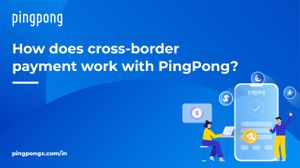
Introduction
eCommerce started in India in 1995 with the launch of the internet. After sustaining itself for more than two decades, it is evident that eCommerce is going to continue here for a long time. With it changed many things like international payments, fast shipping, fast refunds, and exchange. Considering the change in buying behaviour, the convenience of digital shopping and the expansion of work boundaries, the execution of cross border payments have grown manifolds.
India is the largest receiver of inbound remittances, amounting to $83 billion across the globe, accounting for 15% of the global share in 2019. The beginning of 2020 showed marks of higher receipts with $27.4 billion in the first half. Backed by technology and the internet, cross border payments have penetrated the financial world in India. As a result, it has facilitated trade and professions more than ever before.
Different payment processors like PingPong further promise to boost the transfer of funds across the border. These financial players have played quite a substantial role in promoting the volume of businesses over the international boundaries. Let us see how cross border payment works with PingPong.
Table of Contents
- Cross border payments: Things to know before you choose a payment solution provider.
- What is the difference between a payment solution provider and a payment gateway?
- How does cross border payment work with PingPong?
- Conclusion
Cross border payments: Things to know before you choose a payment solution provider.
Trying to work out the problem of receiving cross-border payments? Thinking about how you can flourish in the business with secure payment options?
Cross border payment solutions are the key to have a hassle-free expansion.
Earlier international payments took more than seven days. But with the rising demands and changes in requirements of trade and profession, the systems have upgraded to the fastest transfer possible.
As a result, payment solution providers brought for the users quick and safe cross-border payment solutions in the form of payment gateways and payment processors. Now the question that arises is how can you pick the best processor for you. Here are the factors that you must consider before choosing the right payment solution provider:
- Ease of set up and use: The PSP must be easy to set up, and there must not be much of a hassle for the users.
- Third-Party Integration: The PSP must have the capacity for quick third-party integration. For example, if you want to integrate it into the eCommerce selling platform, it must be easy to do that.
- Types of Payments Accepted: You must accept different kinds of payments with the payment service provider.
- Customer Service: Check the status of the customer service and the turnaround time for the payment related issues. It is one of the essential criteria because you always look for quick solutions when you are stuck.
- Fees and other Service Agreements:
- Processing Fees
- Currency Conversion Fees
- Flat Fees
- Subscription Fees
- Annual Fees.
- Currencies Allowed: Verify the currencies you would want to receive the payment from your customers or clients. It is important as otherwise, you will find trouble in receiving payments.
- Territories of Use: Check before finalizing the payment service provider the geographies where you can use the PSP to receive the payment.
Before choosing the payment service provider, be it a payment gateway or a payment processor, these are the factors you must consider.
Unsure of what to choose?
The first thing you must know is the difference between the two.
What is the difference between a payment solution provider and a payment gateway?
A payment gateway is the payment solution provider that keeps the financial information of the merchants safe. The transfer of the information between the payment gateway and the bank is encrypted. You can accept online payments as the payment gateway is integrated with eCommerce platforms.
The merchants use the payment gateway to accept debit or credit card payments from the customers. The main job of the payment gateway is to validate customer’s card details and ensure that the funds exist before the proceeds are extended to merchants. It is a connector that aligns the financial transaction between the payment processor and merchant account.
On the other hand, a payment processor is a company that takes care of all the transactions when customers buy the products. First, the processor relays the payment information from the customer’s bank to the merchant’s bank. Then, after confirming the availability of funds, the transaction gets complete.
How does cross-border payment work with PingPong?
PingPong is the world’s leading financial service provider that facilitates cross-border payments. Largely, eCommerce sellers, freelancers, and professionals avail the services from PingPong. At present, PingPong has processed cross border payments of more than $90 billion for more than 1 million sellers.
PingPong started just just 3 years ago and in such a short span it has a huge customer base. Mr. Shreya Kumar- Cofounder Aadvik Food said, “Receiving International Payments from Online Customers, PingPong made it really easy for us to receive international payments from our online customers at the best rate we found. Thanks to PingPong, we are now doing business in more than four countries. I tell every seller I can to use PingPong and reap the benefits like Aadvik Foods has.”
There are many such payment success stories. That is great, but the primary fascination lies in how the cross border payment works with PingPong?
PingPong: Cross border payment processing:
Step 1: As a user, you will have to create an account where you are operating. For example, if you sell your products in the USA, you will make a virtual account in PingPong USA.
Step 2: After you have created your PingPong account, mention your local bank account details and link the two.
Step 3: Mention at the eCommerce marketplaces or freelance marketplaces your PingPong US virtual account details.
Step 4: After receiving the payment from your customers, the amount will be credited to your local bank account within 1 or 2 days.
The procedure of receiving the payment through PingPong is now clear. But still the question arises is why choose the payment processor-PingPong?
These are the benefits of choosing PingPong as the payment processor:
- As a merchant or a freelancer, you get to receive the amount at the lowest foreign exchange rates using PingPong.
- The processor allows you to receive the payment in international currencies and convert your sales profit to the domestic currency as fast as possible.
- PingPong manages multiple marketplace profits under one platform.
- You can pay all VAT, GST and other taxes to avoid all the confusing conversion fees.
Conclusion:
PingPong is a service provider that allows eCommerce sellers as well as freelancers to operate in multiple marketplaces. It is a safe payment processor that converts the international payment to local currency at a competitive rate in less than 2 days. With PingPong, users can withdraw funds in currencies like USD, INR, GBP, EUR, CAD, AUD, and JPY. Accept payments from worldwide at the low cost of exchange and no hidden fees only with PingPong. For more information, visit PingPong.
FAQs
Q1. What are cross border payments?
Answer: Cross border payments are transactions where the receiver and the payer are based in two countries. For international trade, cross border payments are an integral part of the operations. In common, it takes more than 5 to 7 days for international payments.
But with the payment processors, the duration of fund transfer is reduced to 1 day. The transfer of international payments taxes your pockets. This is why you must find the best suitable payment solution provider that completes cross border payments at a low cost.
Q2. What are the different types of cross border payments?
Answer: Cross border payments can be made in several ways, including credit card payments, alternative payment methods, and bank transfers. The type of payment you choose will depend on the type of the business and the place you operate.
To complete the cross border payment, you will require the International bank account number and bank identifier code. Merchants can make B2B and B2C SWIFT payments.
To optimize the payment procedure, it is advisable that as a merchant, you do these:
- Adopt the language of the region you operate.
- Work with local partners.
- Provide local payment methods for convenience.
Q3: What is the SWIFT cross border payment system?
Answer: Transforming the digital payment method across the international boundaries, a standard procedure to work out the transfer of funds. SWIFT in banking refers to the vast messaging network used by the banks and several financial institutions. It is used to send the money transfer information over the secured network.
Bringing innovation in the digital payment methods, SWIFT has brought convenience, enabling banks to provide their customers with a fast payment solution. As a result, making cross border payments has now become quick and predictable.
Q4: How long does the cross border payments take?
Answer: International payments typically take four to five days. If the transfer of funds involves more than one financial institution, then the time taken is more. This is why an eCommerce seller must prefer to receive cross border payments in local currencies. For that, they must use a payment processor that has tie-ups with different banks in the territories they want to sell.
Q5. Why are cross border payments necessary?
Answer: Cross border payments are essential to promote the business of merchants and freelancers across the world. When the payment methods are resolved, the fear of losing money in trade reduces. Cross border payments have transformed the businesses, with manufacturers expanding their supply. Growth and increase in revenue are driving the market competitive, thereby making cross border payments more critical.

